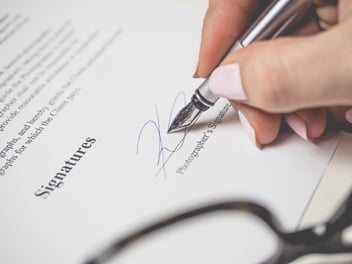ML - CTA Ultimate Guide to Board Meeting Agenda & Minutes (Template)

A clear board meeting agenda is key for running a great board. When in charge of an organization with a board of directors, there are essentially two sides to running a great board: 1. ensuring your board is successful in overseeing your company, and 2. keeping track of what is done. This blog post comes both with an acclaimed board meeting agenda template and a highly usable board meeting minutes template. If you’re unsure of the exact difference between an agenda and the meeting minutes, or you are soon to attend your first board meeting, don’t worry, we'll shed some light on that here and now.
What is a board meeting agenda?
A board meeting agenda is the table of contents for a meeting held by a board of directors. It is one of the most important parts of any successful board as it improves the effectiveness of board meetings. A board meeting agenda is used by the Chair to run the meeting, so the clearer the board of directors' meeting agenda is, the easier it is for the Chair to run the meeting. The best Chairs spend a fair amount of time composing each board meeting's agenda.
What are board meeting minutes?
Board meeting minutes are the notes that describe the events of the board meeting. The board meeting agenda is the perfect outline for the secretary of the board to use as (s)he drafts the board meeting minutes based on the meeting.
Legally yours
Depending on how your organization is incorporated and in which domicile, all or some of your board meeting agendas may be mandatory, and in some courts of law having regular meetings with agendas prepared in advance may be necessary or beneficial if you find yourself in a court of law.
Even if you are not legally bound to draft and deliver an agenda in advance of the meeting, it’s difficult to run a good board meeting without an agenda. In addition, an agenda shows professionalism and that you respect both your board and the effort they put in.
And even if some or all of the board members are your friends, this is not just another meeting over coffee. It comes with legally binding consequences for yourself, your company, and the members of the board. A good meeting agenda ensures that you know how to run a board meeting even if all the members are people you know well.
One issue at a time
Board meetings tend to have strong-willed people, who are used to running many of the meetings they attend. Many meetings run using the so-called parliamentary procedure of meeting management to ensure that the whole board is considering only one agenda item at a time and all participants get heard for each agenda item.
Different countries have different sets of broadly similar parliamentary rules, e.g., the one typically used in the United States is called the Robert's Rules of Order. Some more informal boards may find the parliamentary procedure too complex for their use and run the meeting using an approach they are comfortable with.
No matter how you run the meeting, considering issues one at a time makes meetings easier to run even if this feels a bit stifling at first.
The agenda is the Chair’s tool to run the meeting
With a clear agenda, the chair (or chairperson, chairman, chairwoman) can estimate the duration of the meeting and ensure that all the items can be covered during the meeting.
The best boards circulate the agendas early enough to ensure that the board members have time to react and propose adding, changing, or removing individual agenda items. This is especially easy with ContractZen's board portal software.
The best agendas help cover routine issues efficiently, give a sufficient view of the state of the business from different points of view and leave enough time to cover important issues and make the best possible decisions.
The agenda is typically collected by the secretary of the board together with the chair of the board well in advance of the meeting. Most meetings start with the acceptance of the agenda – a way to ensure that after the agenda is accepted, each item can be covered one by one without discussion of alternate possible issues that could have or should have been a part of the meeting.
Boards have a lot to discuss and decide and there is typically a pressure to cover more than can be in the time allotted. The best agendas help cover routine issues efficiently, give a sufficient view of the state of the business from different points of view using reports by key members of the management and leave enough time to cover important issues and make the best possible decisions from the company’s and its shareholder’s point of view.
How to take board meeting minutes?
The agenda, as it was accepted at the beginning of the board meeting, is the perfect outline for the secretary of the board to use as (s)he drafts the so-called board meeting minutes based on the meeting. Meeting minutes, minutes, or MoM are the notes that describe the events of the meeting. Taking the board meeting minutes involves keeping a written record of the key items that will be part of the meeting minutes document, the decisions, possible votes or dissenting opinions, the participants, and the duration of the meeting.
By having all major topics, possible links, exact names of people, entities, etc. ready before the meeting, making notes becomes much more efficient and the risk of having to slow down the meeting to adjust to the speed of making notes or having mistakes in the notes is diminished. This is straightforward with ContractZen which works as a sort of a board meeting minutes software.
According to some sources, the name minutes derives from the Latin phrase minuta scriptura (literally small writing) meaning rough notes. This should not be taken at face value. A typical set of meeting minutes is not a report of what has been said at a meeting, but rather what was done at the meeting and why. All decisions of the board must be noted in the minutes.
Best practices of running an efficient board involve using the agenda of the board to guide drafting the template for the meeting minutes. By having all major topics, possible links, exact names of people, entities, etc. ready before the meeting, making notes becomes much more efficient and the risk of having to slow down the meeting to adjust to the speed of making notes or having mistakes in the notes is diminished. A best practice is to use integrated board management software and entity management software for this. You can view the above-linked board meeting minutes template also as a Google Document here.
Board meeting agenda template
Most boards use formatting, where the main parts of the board agenda are numbered. Depending on the locale the customary numbering can be the common Arabic, the so-called Roman numerals, or a hierarchical numbering system. We have not been able to find legal requirements for one type of numbering or another but be prepared for the members of the board to have strong opinions one way or another.
Some companies identify each meeting with a unique number, and this may even be mandatory for your company due to legal precedent. If board meetings are not numbered, a date will suffice. You can view the below-written board meeting agenda template also as a Google Document here.
Header
Remember to include the date, time, and location of the meeting. In addition, if the meeting is being held online, add both the contact details, URL, and possibly other contact details, and remember to add a phone number to the person responsible for providing tech support to join the meeting, if possible.
If the meeting location differs from where you’ve previously typically met, do highlight this, to make sure that embarrassing mistakes are avoided.
1. Call to order
The meeting has formally begun. Any discussion before the opening is kept out of the minutes as it is not part of the meeting proper. Typically, this is a point, where the chair says a few words on the meeting and what is to be accomplished today.
2. Roll call
The chair collects who is in attendance and who is absent. In addition to the attendance at the start of the meeting, possible late arrivals and early departures from the meeting are documented in the minutes at the point where members joined and/or left the meeting.
It’s good practice to document in the meeting minutes whether a quorum was present for decision making, e.g., were a sufficient number of members present to conduct business as a group. Note, that the quorum can change, if a member leaves before the end of the meeting or joins the meeting late.
Anyone reading the minutes must have perfect visibility to who was present at each part of the meeting. Imagine, that the minutes of the meeting are read 10 years down the road by someone, who is not a current member of the board, and (s)he needs to understand how the board came to its decision. Do use the full names of the participants as well to avoid confusion at a later stage. This is a legal document, after all.
3. Approval of the agenda
The chair gives members a chance to propose modifications to the current agenda before moving forward. This is not just a quaint old-fashioned habit, but should be seen as a real moment of consideration – are we using our time as well as we can, and are these the items to discuss and decide today?
Your Chair should be particularly open to suggestions of leaving agenda items out or changing the order if members feel that this is beneficial for making decisions.
4. Approval of previous minutes
Remember to add the date of the previous meeting to this agenda item. If any of the members have not received the previous minutes, they are circulated before the approval. It’s not uncommon to make corrections to the prior minutes, but, when possible, these have been hashed out before the meeting using an online system such as a board meeting software or email.
It’s the duty of each of the board members to ensure that the minutes reflect the prior meeting accurately and due time needs to be given to this agenda item if there is disagreement on a particular topic.
Depending on your local laws and regulations the secretary and/or selected members of the board may need to sign the minutes either online or possibly even physically. The exact regulations depend on your local regulations. When an electronic signature is possible, storing the information in a board of directors software is usually automatic.
5. Officers’ reports
The executives and possible committees report on the past and their forecast of the future. Different boards have different habits, but a report from the CEO on the outlook and initiatives and a report from the CFO on the financial situation of the company is typical for every board meeting and even seen as mandatory in some locales.
Having these reports presented to the board in each meeting can be seen as part of the fiduciary duties of the board members and is seen as part of the reasonable care in monitoring the state of the company.
Many companies use an annual calendar and have a set of reports that occur regularly, but not in every board meeting. For example, a report from the Chief risk officer could be an annual event. A broad selection of reports can be seen as a mandatory part of the legal requirement of ensuring adequate control mechanisms in the company.
A report from the CEO on the outlook and initiatives and a report from the CFO on the financial situation of the company is typical for every board meeting.
Possible appendices should be noted under the agenda item they relate to. Typically, this is obvious, but clarity makes preparing for the meeting easier.
If a decision is expected to result in a decision by the board this is typically stated as a separate agenda item under the New Business section.
6. Special Reports
In addition to the officers’ reports, there may be other reports, such as reports from board-appointed committees or reports on other special topics for the board. Unlike the officers’ reports, these are typically non-recurring.
7. Open issues
Each open issue, an item that has been previously discussed, but needs more discussion or is ready for formal decision making is discussed in turn.
A best practice is to state who is responsible for presenting each open issue and new business agenda item. The presenter or responsible person may be obvious for company insiders, but this is less clear for the external board members.
In addition, do note in the agenda, if an open issue or new business agenda item is expected to result in a decision. Stating in advance that a decision is needed.
8. New business
Each new item of business is presented next as agenda items. Best practices differ, but generally indicating the duration of discussion for each topic is a good way to express how the chair is planning to conduct the meeting.
Likewise documenting for each agenda item in both open issues an new business what is the expected outcome: a decision, a discussion, formal acknowledgment that an item has been before the board, or an information session.
The most important agenda items should be at the top to ensure at least they get covered in detail if the meeting runs out of time.
Some decisions are mandatory and should be noted as such to show that the expectation is not just from the chair, but that it’s a legal requirement.
The most important agenda items should be at the top – this ensures that at least these get covered in detail if the meeting runs out of time.
9. Announcements
This can involve any topic that was not already covered. Typically, announcements do not result in formal board decisions. This may involve anything from congratulating other board members to requesting agenda items for the next meeting. It is not uncommon for a last-minute item to report to belong to the announcement agenda item.
10. Next Meeting
The time and place of the next meeting are typically agreed upon during the meeting. This ensures that the time and place of the next meeting are part of the minutes of the meeting, which need to be delivered to the meeting participants after the meeting.
11. Adjournment
The formal closing, or adjournment, of the meeting by the board chair. A good practice is for the chair of the meeting to say out loud the time of the closing of the meeting. This will be the time that is noted in the minutes.
No surprises
As a final note, we recommend that you try to avoid surprising the participants. If you as an executive have an exceptional report to present, taking the time and having a one on one with the chair before the meeting creates an atmosphere of trust. If you as a chair feel you need to achieve an exceptional decision, it makes sense to remove the risk of being surprised at the board meeting by contacting each board member by phone and ensuring that they have a chance to ask questions individually.





